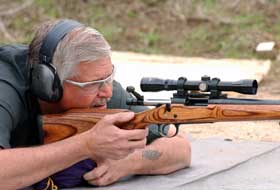I sort of look on reloading ammo as a necessary evil, something you have to do to keep on shooting.
Yes, we're lucky enough to have the shows sponsored by Winchester, who deliver crates of ammo as part of the sponsorship, but that ammo is earmarked for the shows, public appearances and competitions. Itwouldn't be fair to burn it all up in practice. So, it's back to the presses.
My whole strategy on reloading is to make it as easy as possible, with as few barriers to pulling that damn lever as possible. Luckily, I've been accumulated reloading equipment for DECADES...if I remember correctly, I reloaded my first case, a .357, with my father's help when I was 8 years-old. Since I'm now 28 years-old...LOL...okay, I'm 55, so I've been reloading, like, a thousand years.
I will readily admit that Brother Mike Dillon changed my life. When I started competition shooting seriously, I had an RCBS Junior single stage press. If I was a busy little beaver, I could do 100 rounds an hour. A hunded rounds wouldn't even get me through a match, much less practice. I spent a lot of time in the Reloading Cave, needless to say.
My first Dillon 450 was a revalation. Nearly broke me to buy the thing, but it drastically reduced my time in the Cave. The 450 was a progressive press, but not nearly as sophisticated as today's 550 press. To offset some of those shortcomings, we came up with all sorts of Rube Goldberg fixes to, for example, get an automatic powder drop instead of having to push a big button, which, in my case, too often led to one case with NO powder and one case with a DOUBLE CHARGE.
As I spent more and more time writing about guns, I added a second 450 so I could leave my "main" 450 set up for .45 ACP with #68 H&G semiwadcutters — the presses didn't yet have interchangeable tool heads, so changing calibers was still a major pain in the butt. The RCBS Junior was the "prototyping" press for when I had to crank up specialty loads.
Of course, the Stainted Dillon knew all this stuff as well as we did, so the new 550s solved all the problems. He also offred us upgrades from 450-550 status at reasonable prices. I was in hog heaven! The 650 came about 8 years ago when I had more bucks and was shooting a billion rounds a year of .40 S&W in USPSA Limited.
SOOOOOO...my reloading bench now has three Big Blue Machines, the two converted 450/550s — one set up for small primers, the other for large primers — and the 650, set up for whatever competition round I'm shooting (right now, .357 Cowboy loads with 158-gr flat point Laser-Cast bullets and TiteGroup; I exclusively use Laser-Cast lead bullets, because they're good, consistant and available in all flavors; plus the guy who does my FFL transfers is a Laser-Cast dealer). I have a C-H "H" press I use for small-lot precision load development, and I'm currently planning to add an inexpensive Lee Turret press for those calibers I occasionally load but don't want to sink a fortune into...38 S&W, .30 Carbine, .455 Webley, .45/70.
The little Lee turret doesn't take up much space and costs about the same as a full-blown caliber conversion and dies for the 550s. For obscure calibers, I get the inexpensive Lee dies. I've had a couple of the Lee turrets in the past, and they've always delivered the goods.
Other-die-wise, I use the Dillon die-sets, with a couple of change-outs. On my primary competition cartridges, I use a Redding competition seating die and a Lee Factory Crimp die. On .40 S&W and 9mm, I use a special undersize sizing die from George at EGW. I has been a lifesaver on occasion.
Hope this answers some of the e-mail questions!
Monday, August 08, 2005
Subscribe to:
Post Comments (Atom)

1 comment:
Here, I do not actually imagine it will have effect.
Post a Comment